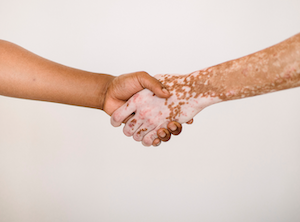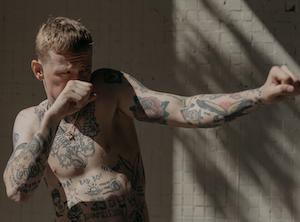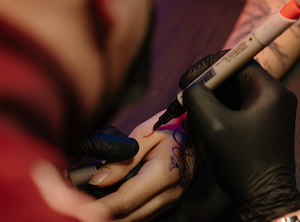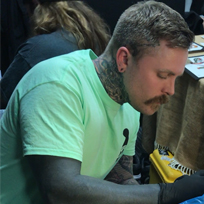Your tattoo machine is probably the most important tool you need for tattooing. Whether you are using rotary or coil machines, it is important that you pay special attention to cleaning and sterilising your machine. Your tattoo machine comes in close contact with the customer and, unlike needles and cartridges, is used repeatedly on different customers.
To avoid any cross-contamination between your customers, and keeping germs and bacteria from spreading, you must not only wrap and cover your tattoo machine (as well as all other equipment used during the session) to create a physical barrier but also clean and disinfect your tattoo machine after each session and customer. In this article, we will show you how to clean, disinfect and sterilise your tattoo machine and which products you need to do so.
1. Covering Your Tattoo Machine and Grip/Tube
Your tattoo machine should always be covered in plastic (or a green alternative) when you are working with it to avoid being contaminated by blood and liquids. You can do this very easily by using a classical machine bag for coil and angled rotary machines. For pen-style machines, it is best to use a fitting clip cord sleeve that you can put over the machine. Don’t forget to also cover your grip when you are not using disposable grips. Take care to seal the plastic bag with either a rubber band or cohesive bandage. Needless to say, these items should be kept in a drawer and not lay openly around your working place to keep them from being contaminated by splashing liquids.
This way you can prevent contamination on your machine to a good grade in the first place and the cleaning effort is not as much. Disposable grips and disposable tubes are a great choice if you want to work clean or if you do not have the time and equipment at hand (at conventions for example) to clean and sterilise your machine and grip/tube after the session.
When you cover your tattoo machine and have it sealed inside the plastic bag, as well as taking care that it does not come into contact with any liquids, blood or any other working equipment (that includes your used gloves), you do not need to sterilise your machine for the next customer. Nonetheless, you need to clean and disinfect your tattoo equipment, even though it has been sealed in a plastic bag.
Always use a new plastic bag for each new customer as well as changing your gloves and cleaning your working place. Also consider changing the plastic bag occasionally when working in long sessions, because the bag might become leaky over time. The same applies to your gloves.
We still recommend sterilising your machine after each use to eliminate the risk of cross-contamination.
If the plastic bag is somehow broken or leaky, you need to clean, disinfect, and sterilise your tattoo machine after the tattoo session.
2. Cleaning Your Tattoo Machine
After and before a tattoo session you should mechanically clean your machine with a disinfectant and paper tissues. To do this, disassemble your tattoo machine and lay all parts in front of you. Put on a new pair of medical gloves and start with the first piece.
Wipe all parts of your machine thoroughly. Do not forget to clean the accessible inside parts of your machine and tattoo machine grip (if you are not using disposable grips). This can be a bit tricky and you might need to use a cotton tipped applicator to get to every last cranny of the machine.

Now your tattoo machine should look clean and shiny like when you first bought it, without any stains or visible dirt.
Keep in mind that your tattoo machine is now mechanically clean, but it is not sterile and therefore not yet ready to be used with your next customer.
3. Disinfecting Your Tattoo Machine
After you cleaned all machine parts mechanically, you can now progress to disinfect your machine. For this, use a disinfectant spray of your choice, spray it on the part and let it dry for a good 10 minutes to become effective. Then turn your equipment and do the same until you have sprayed the disinfectant on all sides of the parts.
Always wear fresh medical gloves when touching any of the equipment and pay attention not to contaminate the machine parts by touching the unbagged disinfectant spray bottle. After spraying all parts with disinfectant and letting it dry you can now use an alcoholic solution (or alcoholic wipes) to wipe off any residue of the disinfectant with a paper tissue. When you followed these steps, your tattoo machine should now be disinfected.
It is important that you not only disinfect your tattoo machine, but all equipment you used during the tattoo session. This includes any reusable grips and tubes, cables and of course your power supply as well as your working place, tattoo (client) chair, and so on.

4. Autoclaving Your Equipment
The safest way to avoid cross-contamination and eliminating all germs, virus and bacteria is an autoclave. An autoclave does not eliminate the before mentioned but it does vastly reduce the risk of contamination to a very, very low degree (0.0001%). The autoclave sterilises any parts inside with a combination of high pressure, heat, and steam. Unfortunately, tattoo machines cannot be put into an autoclave because the motor cannot take this combination (the only exception is LACEnano machines, which are specifically designed to be autoclaved).
If you can remove the motor of your machine you can autoclave the body parts. If you cannot remove the motor of your machine, you should use cold sterilisation.
If you are not using disposable grips and/or disposable tubes, you should autoclave your grips/tube. Only this way you can guarantee the safety of your customer. An autoclave is the best and most efficient way of sterilising your tattoo equipment.
5. How To Sterilise A Tattoo Machine Without An Autoclave (Cold Sterilisation)
If you do not have an autoclave, you can also use an ultrasonic cleaner as an alternative. The ultrasonic cleaner uses high frequencies in combination with a chemical cleaning solution to eliminate any contamination on your equipment.
While the ultrasonic cleaner does a great job at cleaning your equipment, it will not sterilise your equipment!
Another method of cold sterilisation is chemical baths. These take much longer (8 to 24 hours) to be effective but are a good method of getting your equipment usable for the next customer. Perhaps overnight.
Unfortunately, these methods are not as efficient and safe as an autoclave. If you do not have an autoclave, you should pay extra-high attention to properly disinfecting your equipment and sealing your tattoo machine in a plastic bag. Also, you should consider using disposable grips and disposable tubes as they come pre-sterilised and lower the risk of cross-contamination for your customers.
6. Tattoo Needle Cartridges

Tattoo needle cartridges are a safe way of tattooing without the need for autoclaving your tattoo equipment after each session. Thanks to the membrane featured on most reputable brands, liquids cannot enter the grip, tube, and tattoo machine. This means, your tattoo machine does not come in contact with germs, bacteria and viruses and, if you seal it properly for the session, only needs to be disinfected after each session. We recommend using tattoo cartridges if you do not have access to an autoclave.
7. Conclusion
In this article, we showed you how to clean and disinfect your tattoo equipment and various methods of sterilisation. Hygiene is one of the most important topics for tattoo artists and it cannot be stressed enough that you should take all measures to prevent any cross-contamination. If you want to read further about tattoo machines, check out our article on Tattoo Machines: Rotary vs. Coil.














 What Is A Prince Albert Piercing?
What Is A Prince Albert Piercing? The Best Tattoo Ink 2024
The Best Tattoo Ink 2024 Tattooing Over Stretch Marks, Moles, Scars And Other Skin Conditions
Tattooing Over Stretch Marks, Moles, Scars And Other Skin Conditions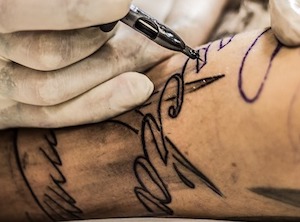 11 Best Fonts For Tattoos 2022
11 Best Fonts For Tattoos 2022 Advice For An Itchy Tattoo
Advice For An Itchy Tattoo

